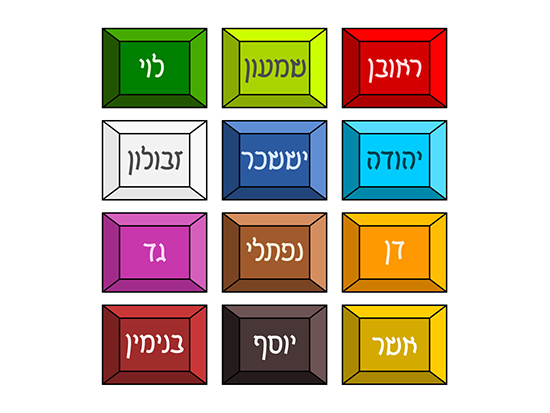Parshat Tetzaveh: The Might of The Shoham Stones

Depiction of the shoham stones. Photo: רונאלדיניו המלך. CC 4.0
2/23/2024, 4:00:00 PM
This week’s parshah primarily focuses on the making of the garments of the kohanim [priests] of the Tabernacle. [Interestingly, it is the only Parshah after Shemot where Moshe’s name cannot be found – much ink has been spilled to offer varied approaches to why that is the case].
There were a total of eight articles of clothing for the high priest [Kohen Gadol]; perhaps the holiest of those eight were the breastplate [choshen] and the apron-girdle, [ephod]. The breastplate contained the names of the 12 tribes as well as the three forefathers on 12 mystical stones; inside a folded compartment rested the 72-letter name of G-d. The apron-girdle had two shoulder straps that were linked to the breastplate; on each of the shoulder straps rested a “shoham” stone that had inscribed on it six tribes of Israel. Thus, the Kohen Gadol represented the unifying entity of all of Israel resting on his shoulders–he was Am Yisrael’s agent in front of G-d, and the epitome of his service would come every Yom Kippur when he would enter the Holy of Holies as no other mortal could.
Mysteriously, Kli Yakar comments [28’ 9’] that the Hebrew word “shoham” contains the letters Shi’’n He’’h Me’’m, which can be rearranged to form the words “Hashem” and “Moshe,” as the true vision of a unified Israel required commitment to G-d and His Torah that was handed to us through Moshe – hence, the apron-girdle stones were to be made of this material known as shoham!
Interestingly, Rokeach [ad. loc.] offers an astounding allusion to the deeper meaning of the shoham stones on the apron-girdle. The Torah [Shemot 25’ 10’] writes in reference to said stones that each one should contain “the names of six of the Tribes on one stone…[and the names of the six remaining tribes on the other stone].”
When looking at the three Hebrew words that form the phrase “six of their names on one stone,” Rokeach notices that the first letters of those three words are Shi’’n Me”m Ayi”n, which spells the word “Shema.” Contextually, Rokeach explains that there are six words in the phrase “Shema Yisrael H’ Elokeinu H’ Echad,” and six words in the accompanying phrase “Baruch Shem Kevod Malchuto Le’olam Va’ed.” The above two pesukim [verses] are from among the most well-known to nearly every Jew; the origin of those two pesukim is recorded in the Talmud [Pesachim 56A] as a reassurance to our forefather Yaakov on his deathbed that our faith in Hashem as the one true G-d was strong; and through struggle and torture, pain and Holocaust, the echoes of that reassurance still ring in the air as our soldiers battle ancient manifestations of Jewish hatred, and the world once again seems to beckon forth those who seek to destroy us.
Rokeach concludes that the six names of the tribes on each of the two shoham stones correlates with the above two pesukim that each contain six words; ergo, the “shoham” stones were meant to represent our unwavering commitment to Hashem. The High Priest, as the messenger of the united force of the Jewish People, bore these two stones on his shoulders, to highlight that when Jews are united in their service to G-d, they cannot be defeated.
May our brave soldiers, who marched into battle with the words “Shema Yisrael” on their lips, merit to be at the forefront of those greeting the High Priest upon the arrival of Moshiach speedily in our days.